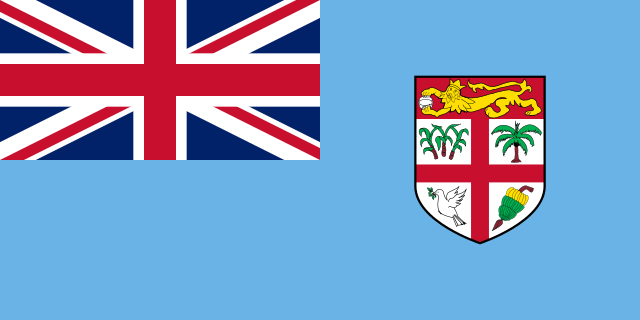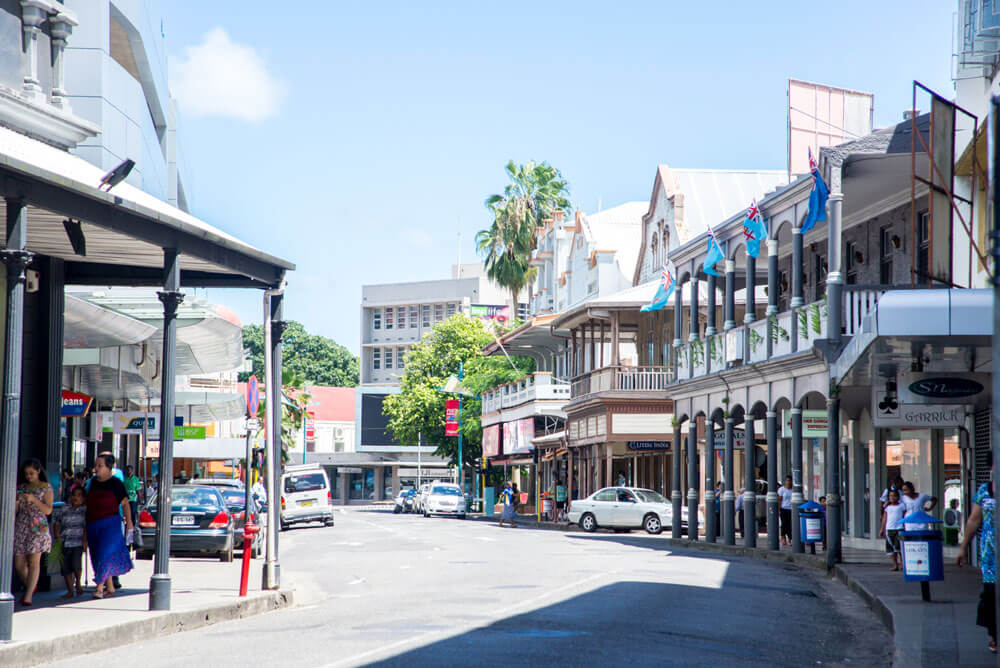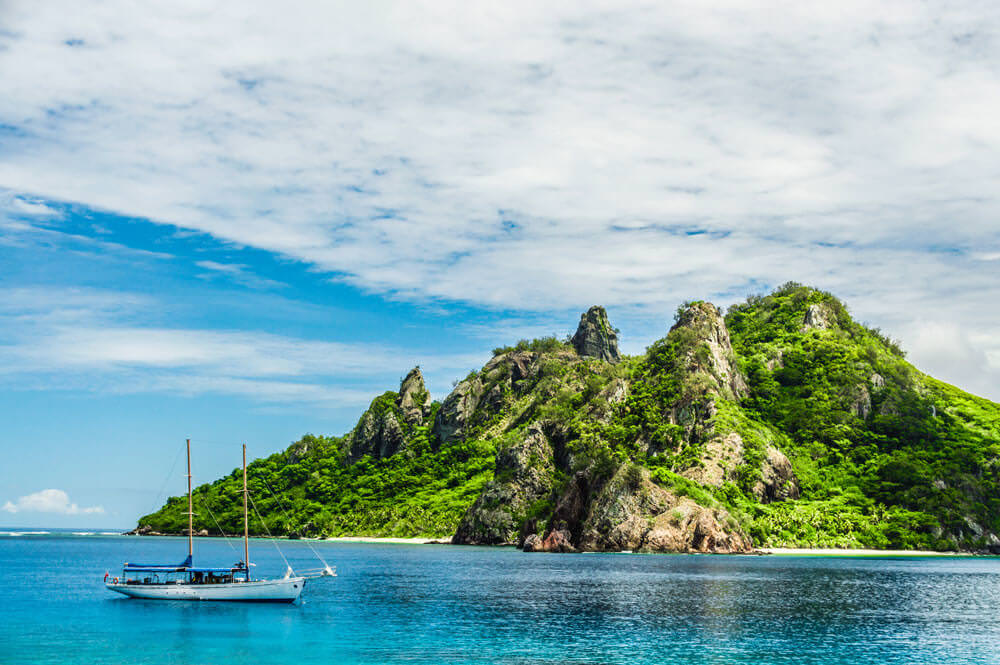Fiji

Capital city: Suva
Population: 902,234 (2021)
Land area: 18,333 km²
Official languages: English, Fijian, Hindi
Legal system: A national civil law system
Time zone: GMT+12
Currency: Fijian dollar
GDP: 4.80 USD Billion (2021 est.)
Main industries: Tourism, sugar processing, clothing, copra, gold, silver, lumber
Principal exports: Sugar, garments, gold, timber, fish, molasses, mineral water and coconut oil
An island group in the South Pacific Ocean in between Hawaii to New Zealand, the Republic of Fiji comprises an archipelago of more than 330 islands of which about one hundred are inhabited. Most of the islands were formed by volcanic activity. It surrounds the Koro Sea about 1,300 miles (2,100 km) north of Auckland, New Zealand.
Due to its formation upon ancient rock formations, Fijian islands are predominantly a result of volcanic activity giving rise to its mountainous and rugged topography with sedimentary deposits and coral formations scattered across the islands. Half of Fiji’s total area, despite the volcanic structures, is laden with forests. Dry grasslands can be found in the western regions of the larger islands and coastal areas across all islets comprise of coconut palms, tropical vegetation and majority of the shorelines are bordered with coral reefs, rocks and a few also have white sandy beaches; mangroves can be found more so on the eastern coastlines. Of all the islands, Viti Levu is the largest, both in terms of size and population, with a total area of 10,000 sqkm making up about a half of the total land area of Fiji. The island is bifurcated by a mountain range running from north to south; this range also harbours Fiji’s highest peak known as Tomavini which is approximately 4,344 feet.

Demographics
Fiji’s population of 943,737 (as of July 2022) is comprised mostly of iTaukei, predominantly Melanesians with Polynesian roots, at 54%. Indo-Fijians account for 38% of the population. Migration has reduced the percentage of Indo-Fijians dramatically over the last 20 years. Approximately 1% of Fiji’s population are Rotuman, who are natives of Rotuma Island. Approximately 43% of the population is below the age of 25.
Roughly half of the population lives in urban areas, with an estimated 70% of the population living on the island of Viti Levu. Protestantism is the dominant religion practiced by 45% of citizens, followed by Hinduism (28%), Roman Catholicism (9.1%), Islam (6.3%), Sikhism (0.3%), and others. Fiji has three official languages: English, iTaukei, and Fiji Hindi.
History
The first settlers to arrive to Fiji are said to be the Melanesians that arrived from the islands of Melanesia approximately 3,500 years ago. These settlers were known for their pottery known as Lapita ware, their horticultural knowledge, navigation and canoe-building skills, and the wide range of food plants and pigs that they brought to the island with them. They created small communities in the ridge forts of Viti Levu and larger communities could be found in the delta regions in the southeast. The society focussed on complex irrigation systems and massive ring-ditch fortifications to grow produce such as taro. The people divided themselves into clans and residential subclans, known as mataqali, and leadership within these communities was hierarchal and based upon both merit and ancestry. Soon communities began to expand and fragment, and while some communities allied to form confederations supervised by paramount chiefs, warfare was common.
The first European arrival on the island came in 1643 when the Dutch explorer Abel Janzsoon Tasman passed by the northeast fringe of the island group. Captain James Cook crossed the southeastern island in 1774 and then William Bligh made landfall in 1789 and then subsequently in 1792 when he returned to explore the area further. In the late 19th century, foreign arrivals on the islands became more frequent due to the discovery of sandalwood. By 1820 most of the sandalwood reserves had waned but the discovery of sea cucumbers revitalised foreign interest and soon the local Fijians were brought into the harvesting of these commodities. This gave way to new wealth and power due to which political rivalries between the local confederations became more widespread and ultimately the fighting led to the creation of the kingdom of Bau which went on to dominate the whole of western Fiji by the 1850s. A decade later Fiji began welcoming foreigners intending to set up cotton plantations following the boom in prices as a result of the American Civil War. However, this soon devolved into political and physical fighting between the local Fijians and the foreigners largely over land ownership, which was further exacerbated by the import of labourers from nearby Pacific islands. Since the chiefs of the different clans and confederations were unsuccessful in their efforts to unite against foreign invasion, their defense soon fell and on 10 October 1874, after several rounds of negotiations, Fiji officially became a crown colony under British administration.
Under the administration of Arthur Gordon, the first governor of the newly established colony, the traditional political structure was maintained and the British implemented an indirect system of rule over the Fijian community, allowing them to be taxed in agricultural commodities rather than money and the sale of the local land was banned while the Fijians were in turn partially blocked from the commercial and political decision making outside their local systems. To promote economic expansion and development, Indian labourers were brought to the islands to kickstart sugar plantations and processing mills. During the Second World War, Fijians served in the army of the Allied Forces in the conquest for the Solomon Islands; the loyalty of the Fijians during the War led to a restructuring of the political administration after the War had ended which subsequently created the 1966 constitution. The constitution created a new system of administration that was a mixture of parliamentary democracy and the ethnic customs and divisions of the local society. Franchise was extended beyond foreigners and Indians to include Fijians other than the chiefs who acted as their representatives; the protection of the Fijians’ land rights were also promulgated under this constitution.
Fiji became independent on 10 October 1970. Until 1987, the government was formed by the Alliance Party led by Ratu (Chief) Sir Kamisese Mara which followed policies of moderate multiracialism. The largest Indo-Fijian party, the National Federation Party (NFP), formed the main opposition for most of the period and calls from Indo-Fijians for greater political and property rights increased.
Elections in April 1987 resulted in victory for a coalition consisting of the NFP and the Fiji Labour Party (FLP), led by Dr Timoci Bavadra and supported by both ethnic Fijian and Indo-Fijian trades unions. Bavadra, an ethnic Fijian, became Prime Minister. In May 1987, the government was overthrown in a coup led by Lieutenant-Colonel Sitiveni Rabuka, who called for the ethnic Fijian dominance of all future governments.
The May 1987 coup was followed by a period of racial unrest, during which the Great Council of Chiefs attempted to introduce constitutional reforms. Negotiations between Mara and Bavadra resulted in the formation of an interim government of unity. However, Rabuka led a second coup in September 1987 and in October he declared Fiji a republic. Having become a republic, it was then required to reapply for membership of the Commonwealth and, at their summit in Vancouver in October 1987, Commonwealth Heads of Government decided to allow its membership to lapse, primarily on the grounds that Fiji had adopted a form of government at variance with the democratically expressed wish of the people and so with Commonwealth principles. In December 1987 Rabuka appointed a new civilian government with Mara as Prime Minister and Ganilau as President.
Key dates in the history of Fiji
1643 Dutch explorer Abel Tasman is the first European to discover the islands
1830s Western Christian missionaries arrive
1871 European settlers at Levuka Island organise a national government and name Cakobau king of Fiji
1874 Fiji becomes a British crown colony
1904 Legislative Council, consisting of elected Europeans and nominated Fijians, set up to advise the British governor
1970 Independence gained after a century of British administration
1985 Timoci Bavadra sets up the Fiji Labour Party
1994 The Great Council of Chiefs appoints Ratu Sir Kamisese Mara as president in January
1999 – Mahendra Chaudhry becomes first ethnic Indian prime minister after the Fiji Labour Party wins the general election

Legal System and Government
The politics of Fiji take place within the framework of a parliamentary representative democratic republic. Fiji has a multiparty system with the Prime Minister of Fiji as head of government. The executive power is exercised by the government. Legislative power is vested in both the government and the Parliament of Fiji. The judiciary is independent of the executive and the legislature. A new Constitution was promulgated in September 2013, and a general election was held in September 2014, won by Bainimarama’s Fiji First Party.
Fiji’s legal system respects the English Common Law system. In 1990 the judicial system was reorganised by the constitution, but it retains elements of the British system. The judicial system consists of the Supreme Court, Court of Appeal, High Court and Magistrates’ Court, and is presided over by the chief justice. The High Court comprises civil, criminal, family, employment relations and tax divisions, the Magistrates’ Court, civil and criminal divisions, the Juvenile Court and Small Claims Tribunal.
Economy
Fiji is a middle-income country and is comparatively more developed than its regional counterparts. The services sector is the predominant pillar of the economy, contributing 54.8% of GDP value and employing 68% of the nation’s workforce; tourism is the biggest industry within the sector as it contributes about 40% of the GDP and employs 50,000-100,000 of the workforce.
Agriculture has been eclipsed by services as the backbone of the economy but is still very significant, it contributes 13.8% of the GDP and employs around 18% of the working population. The main agricultural products include sugarcane, kava, fruits including coconuts, papayas, mangoes and pineapples and vegetables such as dalo, cassava, yams and other root vegetables; the livestock sub-sector revolves mainly around beef and dairy production. Fiji’s abundance in natural resources, especially gold reserves found in the Vatukoula mine, are important exports, contributing 1.4% of GDP. Overall, the industry sector contributes 18.1% of GDP and employs 14% of the workforce; of this, manufacturing contributes 12% to GDP.
Trade
Fiji’s GDP amounted to US$4.59 billion in 2021. For the year, the top exports were beverages, spirits, and vinegar (13.2%), mineral fuels, oils, distillation products (11.2%), fish, crustaceans, mollusks, aquatics invertebrates (8.6%), and natural/cultured pearls, precious/semi-precious stones and metals (7.2%). Main export destinations were the United States (20.4%), Australia (16.5%), New Zealand (8.2%), and Tonga (5.8%). The top imports of 2021 were mineral fuels, oils, distillation products (16.5%), aircraft, spacecraft and parts thereof (7.2%), machinery, nuclear reactors, boilers (7.2%) and electrical and electronic equipment (6.9%). Fiji’s main import suppliers were Singapore (17.1%), Australia (16.9%), China (15.0%), and New Zealand (14.8%).
Fiji is a signatory of the Melanesian Spearhead Group (MSG), the Pacific Island Countries Trade Agreement (PICTA) and the South Pacific Regional Trade and Economic Cooperation Agreement (SPARTECA). It is also a member of the RTAs between the EU and the Pacific states and the UK and the Pacific States.
Investment Opportunities
Fiji has an enviable strategic position which has contributed to its status as a transportation and communications hub for the South Pacific region. The nation has well-developed public infrastructure and utilities, a literacy rate of 99% and a digital penetration rate of 95%, a good healthcare system, well-established financial and banking institutions that offer a variety of financial services, plentiful land available for building industrial complexes and factories for reasonable rates and a quick and convenient registration system for foreign investors. The nation also has a comparatively low corporate tax rate of 20% which is further subsidised down to 17% if businesses relocate their headquarters to Fiji or 10% if they list on the South Pacific Stock Exchange.
Fiji’s position as the hub of the South Pacific makes it telecommunications infrastructure vital for the region’s business activity; its Southern Cross fibre optic networks deliver the fastest and most secure international bandwidth and with its high skilled English-speaking workforce and the current development of the Modern Economic Zone that will support further infrastructural development and cater to large scale ICT operations, Fiji has immense potential to become a global leader in the ICT sector, making it attractive for foreign investors. Fiji is already well-known as a centre for back office processing and outsourcing and the government also offers several incentives to encourage investment into the sector’s expansion, including duty free importation of computers, computer parts and accessories, plant, equipment and fittings, and specialised furniture for initial establishment. The Fijian government is also focussing on promoting foreign investment in its fisheries; the beautiful coastlines boast numerous diverse marine resources and aquaculture products that supply 34% of the world’s tuna catch. The industry is the third-largest, providing employment and food sources to the nation. However, there is much potential that remains untapped, largely due to underdeveloped and obsolete farming infrastructure and methods. Foreign investment and joint ventures would be immensely beneficial to improving the foundation of Fiji’s fishing industry and for the investors interested in niche markets such as the production and processing of seaweed and unique marine commodities like pearls, Fiji’s Exclusive Economic Zone is a massive pool of potential. Incentives for investment in the industry include income tax exemptions of upto 5 years and import duty exemptions on the importation of raw materials, machinery and equipment. Aside from these, the Pacific nation also offers limitless investment opportunities in tourism, manufacturing, energy, healthcare and mining.